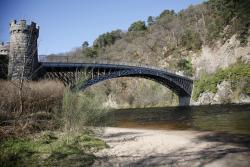Traversing the Great Glen of the Scottish Highlands for 60 miles the Caledonian Canal connects the North Sea by Beauly and Moray Firth on the east coast with the Irish Sea by Lochs Linnhe and Eil on the west. Thirty eight miles of the canal pass through freshwater lochs Douchfour, Ness, Oich and Lochy with the remaining 22 miles formed by earth cutting. Initially 28 locks, and later 29, were required to reach the summit elevation of 106 feet at Loch Oich.
2007


From 1956 to 1993, the GE Re-entry Systems facility was home to thousands of engineers and technicians who solved the problem of vehicles successfully reentering the Earth’s atmosphere. As described by aerospace pioneer Theodore Von Karman, “ Reentry… is perhaps the most difficult problem one can imagine.” Whether it was the first operational reentry vehicle for the Atlas ICBM, the recovery of the first man-made object from orbit, or the first probe to enter Jupiter’s atmosphere, some of the most significant milestones in aerospace were accomplished by those working in this facility.

This elegant cast iron arch bridge designed by Scotland's famous Thomas Telford was built from 1812 to 1814. It is the earliest surviving example of a portable lattice-braced standard type that Telford developed for use at wide and deep water crossing sites unsuitable for masonry spans. At least 10 of these bridge types were erected throughout Britain between 1814 and 1829.

The Cincinnati Observatory, founded by Ormsby MacKnight Mitchel in 1842, is America’s oldest public/professional observatory. The observatory was situated on Mt. Adams, east of the current downtown Cincinnati; the hill was named for former President John Quincy Adams when he laid the observatory’s cornerstone. In 1873 the observatory was relocated to Mt. Lookout when it became a component of the University of Cincinnati (UC). From 1870s until 1930s the stellar proper motion studies reigned as the observatory’s principal activity.


